Due real Fluorescent lamp fire danger I have pretty much tried to get rid of potentially dangerous tradtional starters in the fuorescent lamps. So I replaced the starter with electronic safety model – if bulb does not start, it will stay off without heating. Or at least should. I got one Axxel S10 starter that did not always get the bulb started, and sometimes just stays on keeping the ends of the tube heated (which isthe thing that I was avoiding with electrical started) – and it seems that I was not the only person having this kind of problems with Axxel S10 starter.
So the next question was what to do? Is the fluoscent tube getting too old to start reliably, so I should change it? Maybe. Should I change the electronic starter Axel S10 to a safer model? Definately yes for safety.
But what if I would replace the fluorescent bulb with a modern LED tube. LED lighting is becoming popular all, and it seems that LED tubes designed to replace fluorescent tubes are now available at reasonable price. It would start immediately, which would be a big plus on toilet light. So I should get LED tube.
I did some reasearch where to get suitable LED tube, I needed one that fits on place of around 60 cm long 18W fluorescent tube on lamp that used tradtional magnetic ballast. Biltema had one suitable LED tube on their catalogue, but it was unavailable at the moment. I did some searching and found out that Motonet had two suitable models available for around 10 Euros listed available: Airam LED-loisteputki G13 9W 3000K 900lm and LED – loisteputki G13 9W 4000K 800lm 600mm.
At the shop I selected Airam LED-loisteputki G13 9W 3000K 900lm + sytytin (43-8936). It promised for 10W power intake it promises to puts out 900 lm light output. The tube has traditional G13 bases, has 26 mm diameter and 600 mm length. It came in this kind of package:
Here is the LED tube installed to the lamp.
As you can see it replaced the 600 mm 18W traditional LED tube nicely. I was wondering on how much light it puts out compared to old bulb. A quick testing with my multimeter that has built-in light meter gave good results: Same light output 500 Lux from arms lenght from lamp. The biggest difference on the light was that the ends that do not give out light are considerably longer on the LED tube than original fluorescent lamps, so you don’t get light all the way to the end on the lamp (was not a big issue on this lamp, looked still OK).
The package had also some instructions leaflet hat showed right usage on different kind of fluorescent lamps:
This LED tube seems to do well what is promised at least on my quick tests. It seems that LED technology has become a good alernative to old fluorescent bulb technology.
After this test I am ready to start replacing more of the fluorescent bulbs with LEDs.
Anyone have any recommendations for good replacement for compact fluorescent bulbs with G23 base to lamp that has two of them? It seems that bulbs with bigger G24 base are widely available (I have tested one G24 base LED bulb), but G23 base LED bulbs seem to be hard to find items. Any recommendation where to get them or does any manufacturer/shop has few free samples to test?
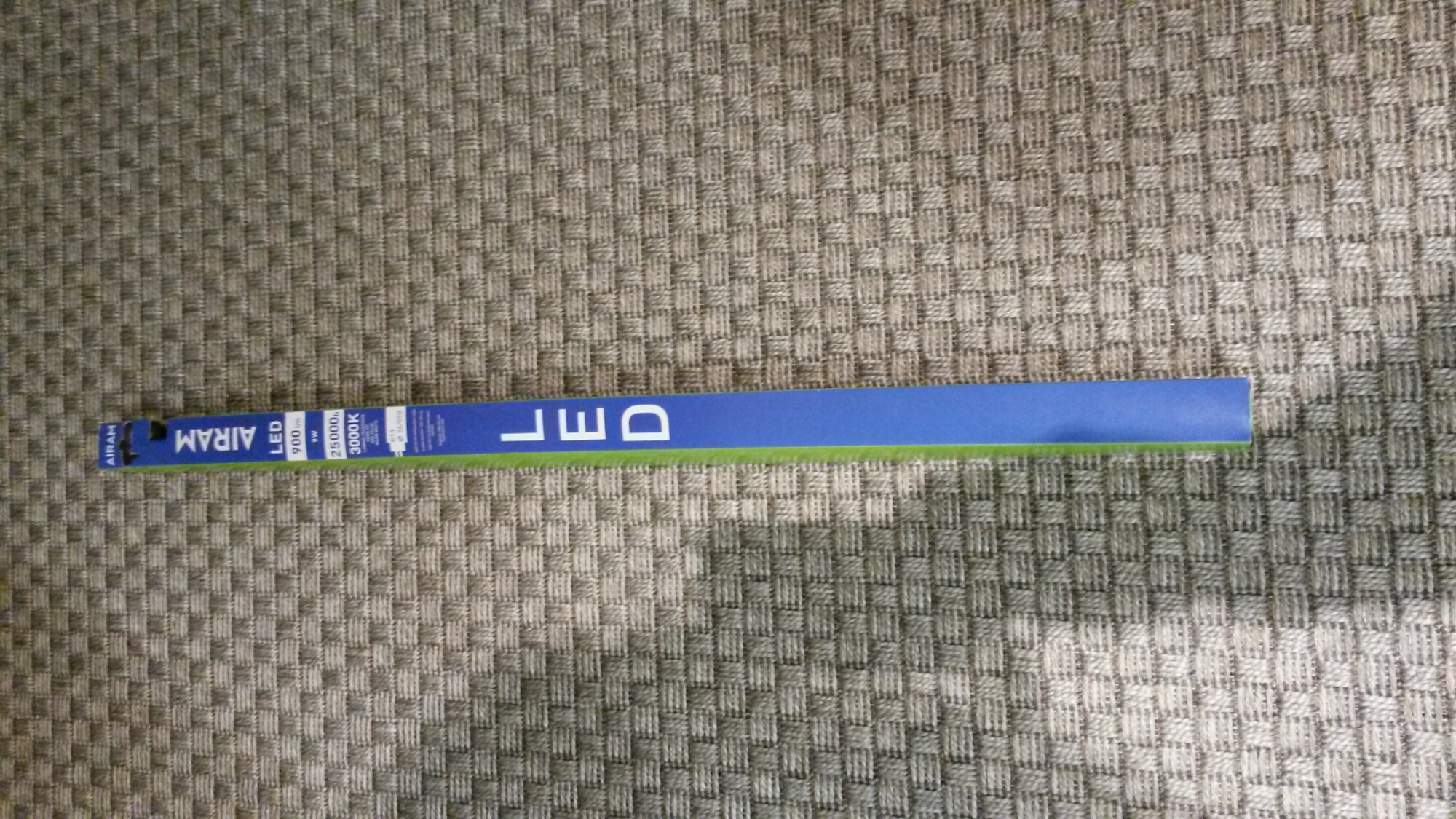
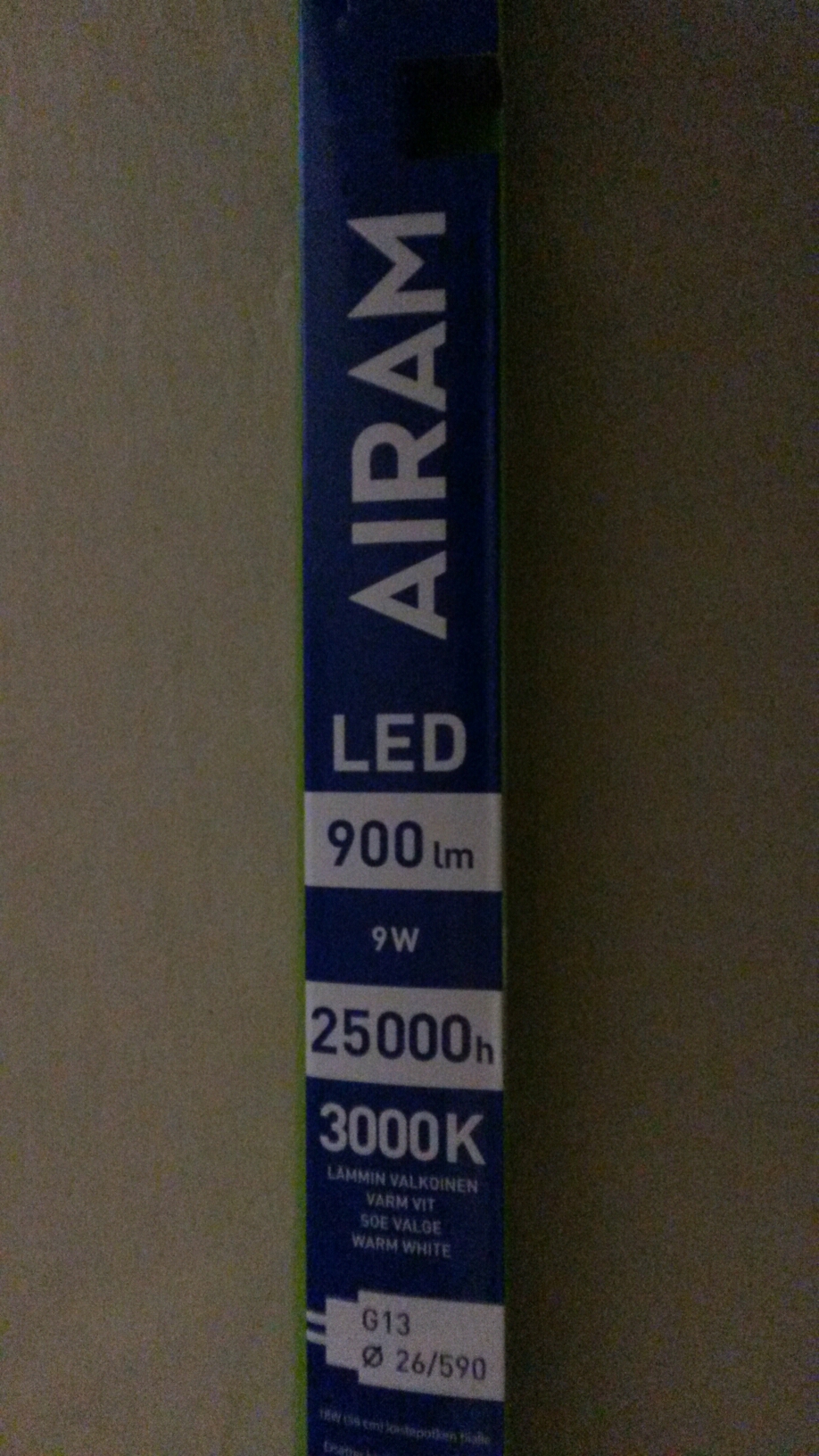
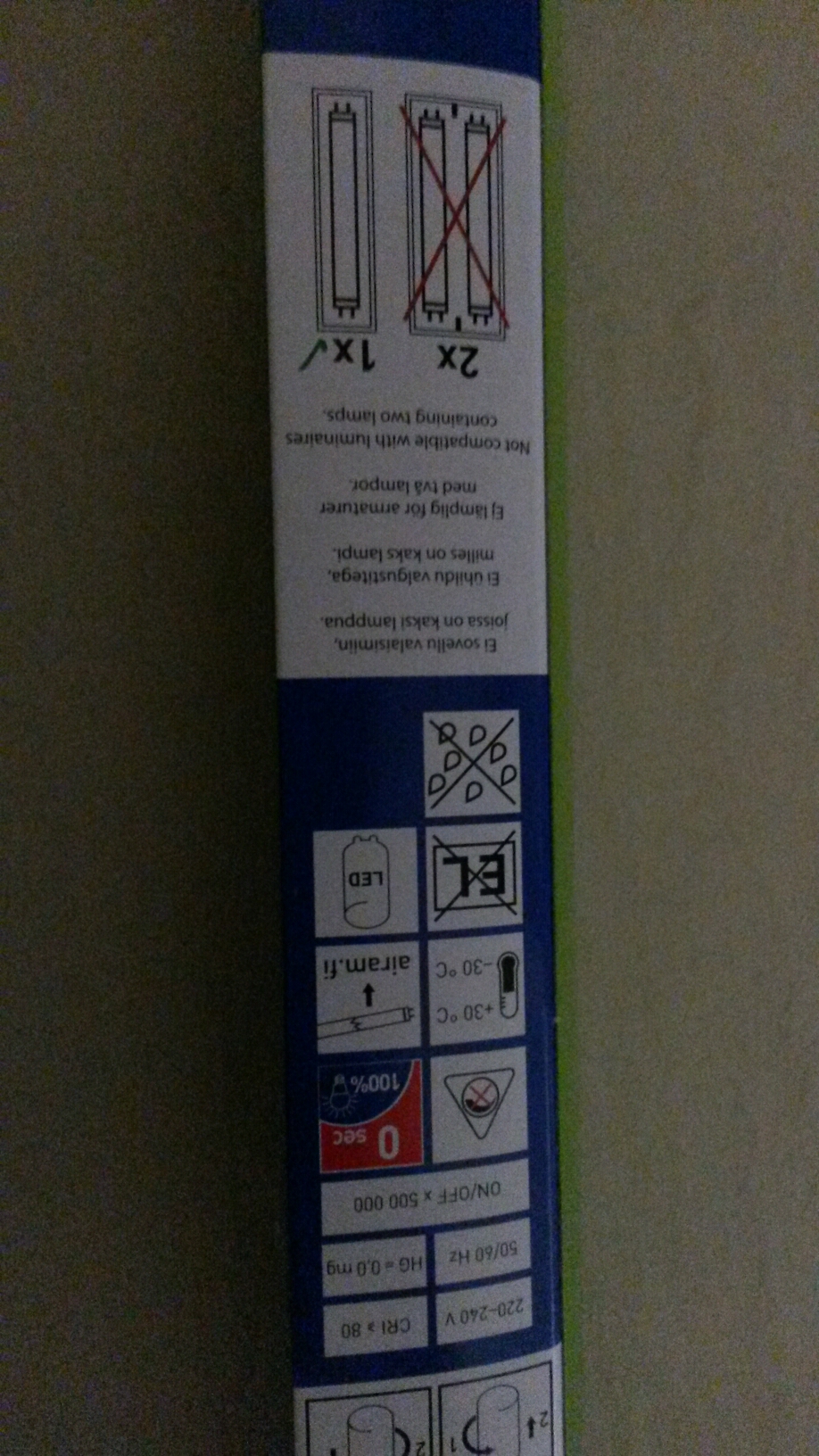
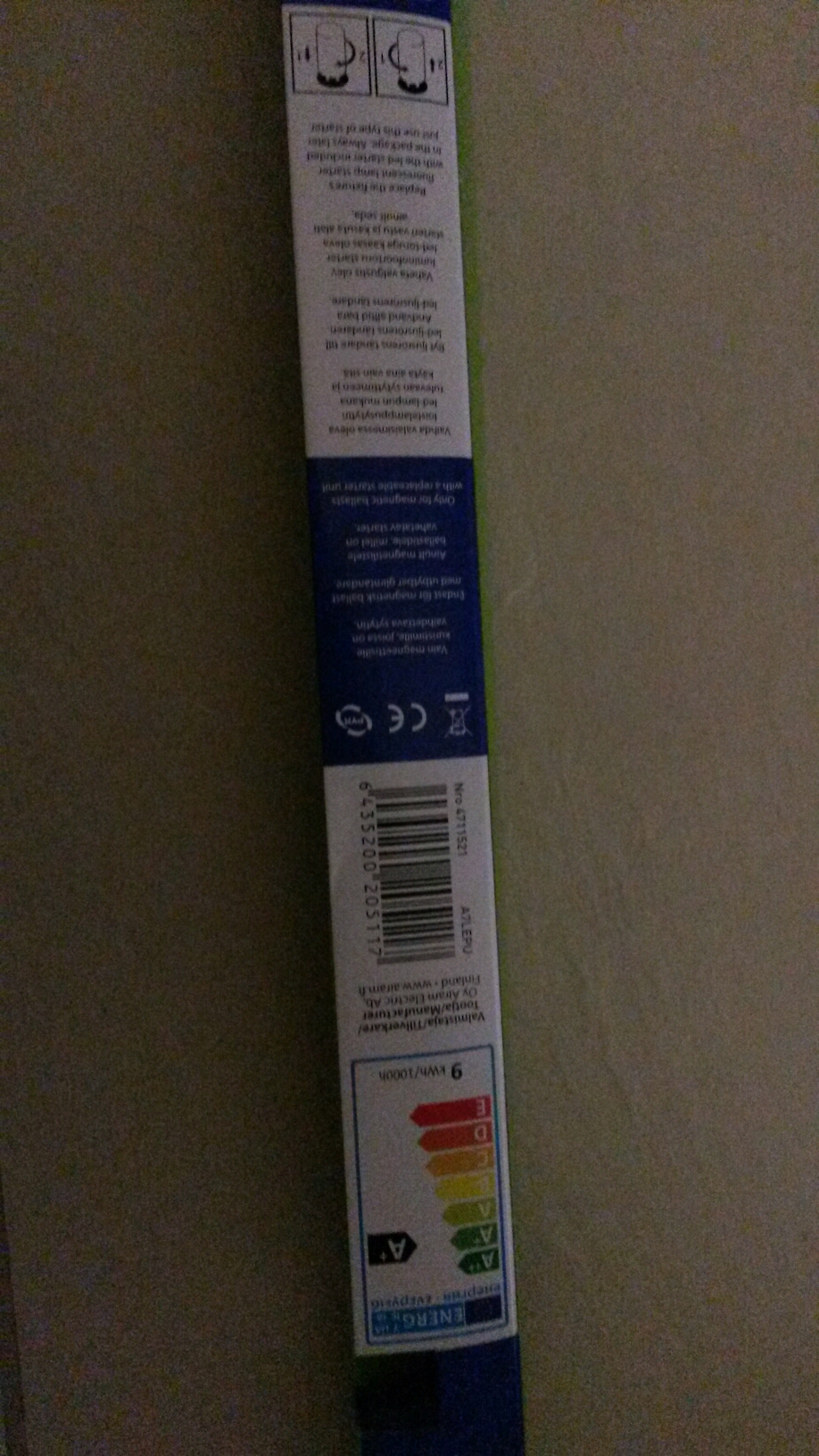
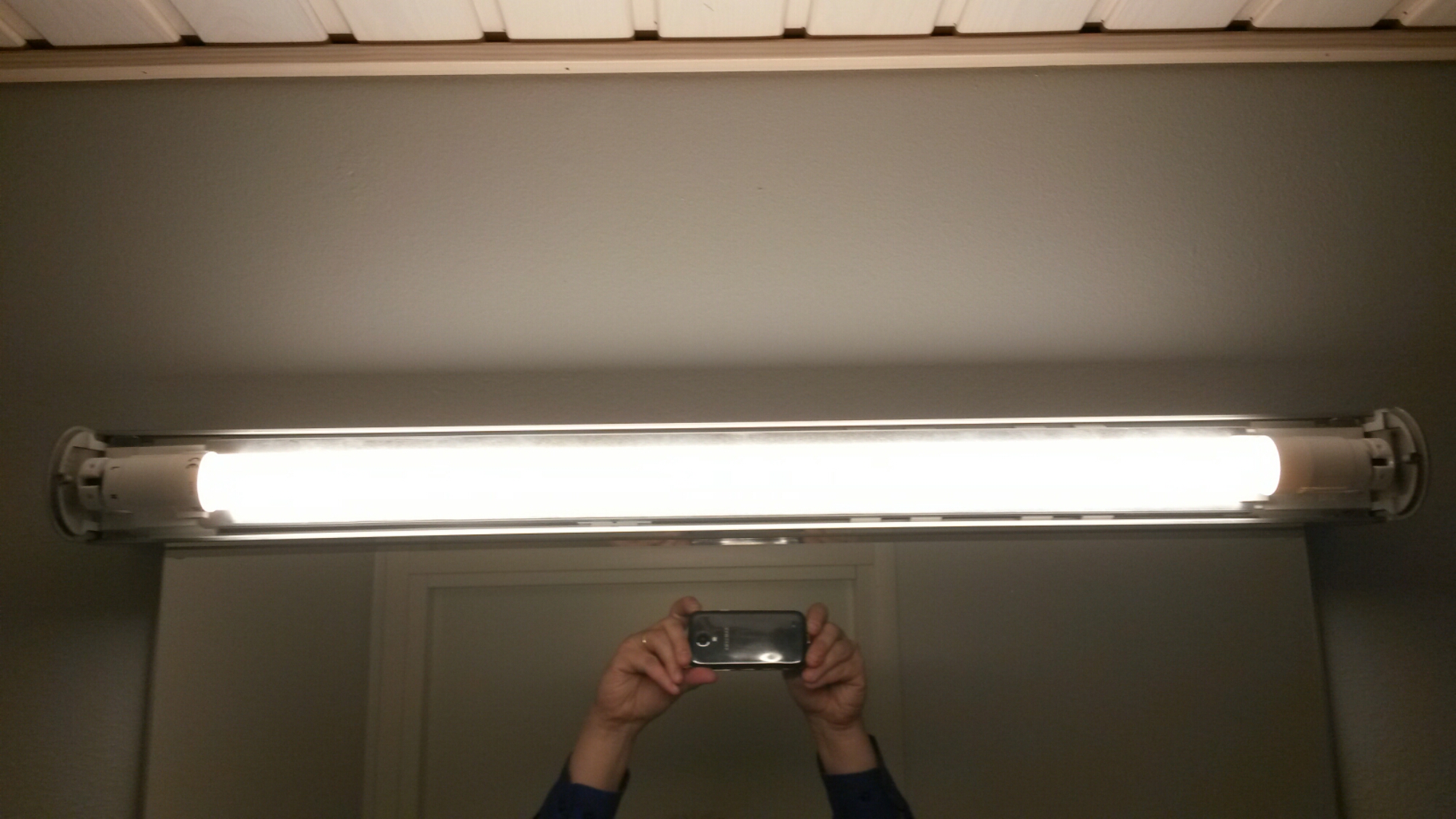
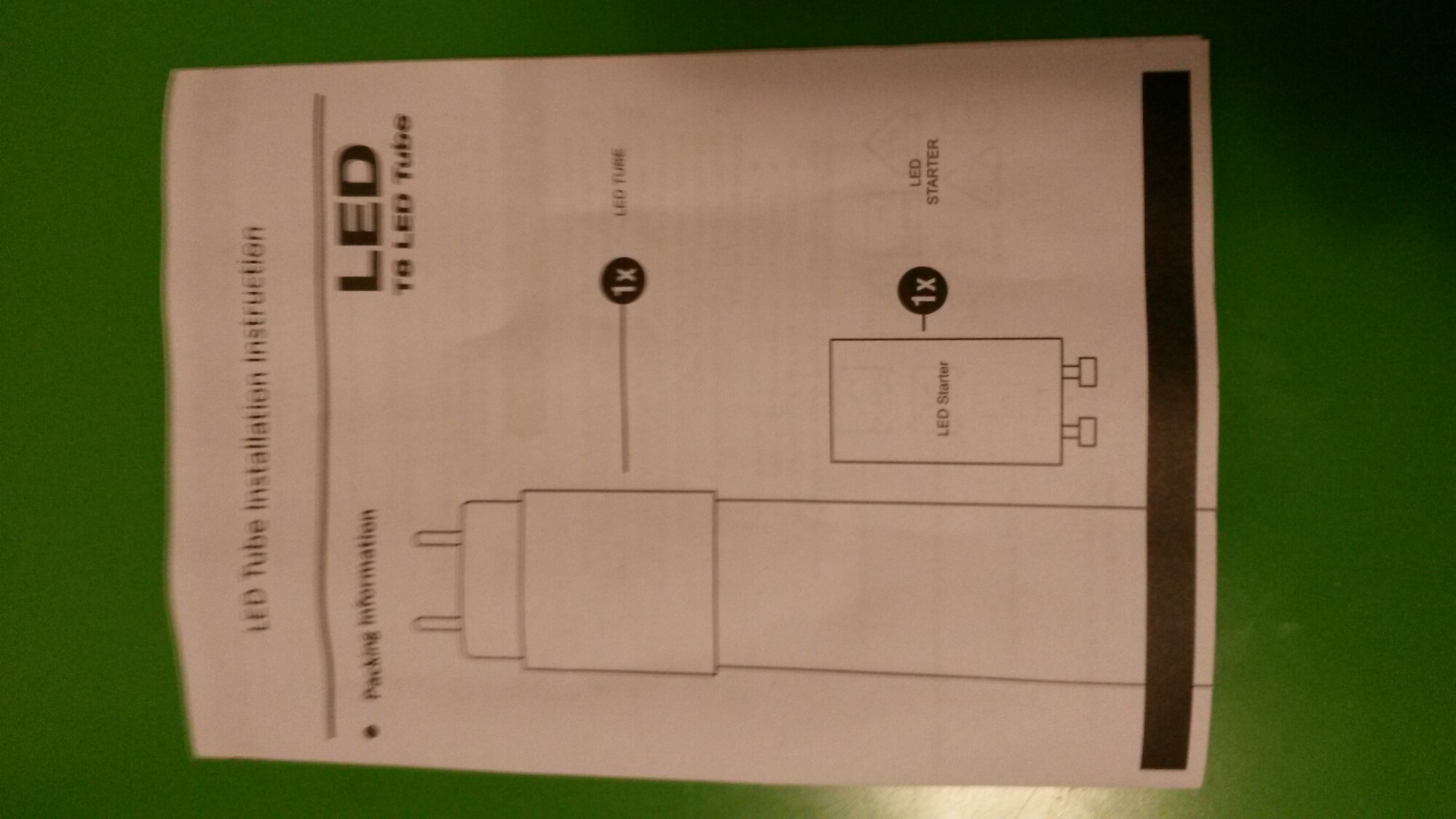
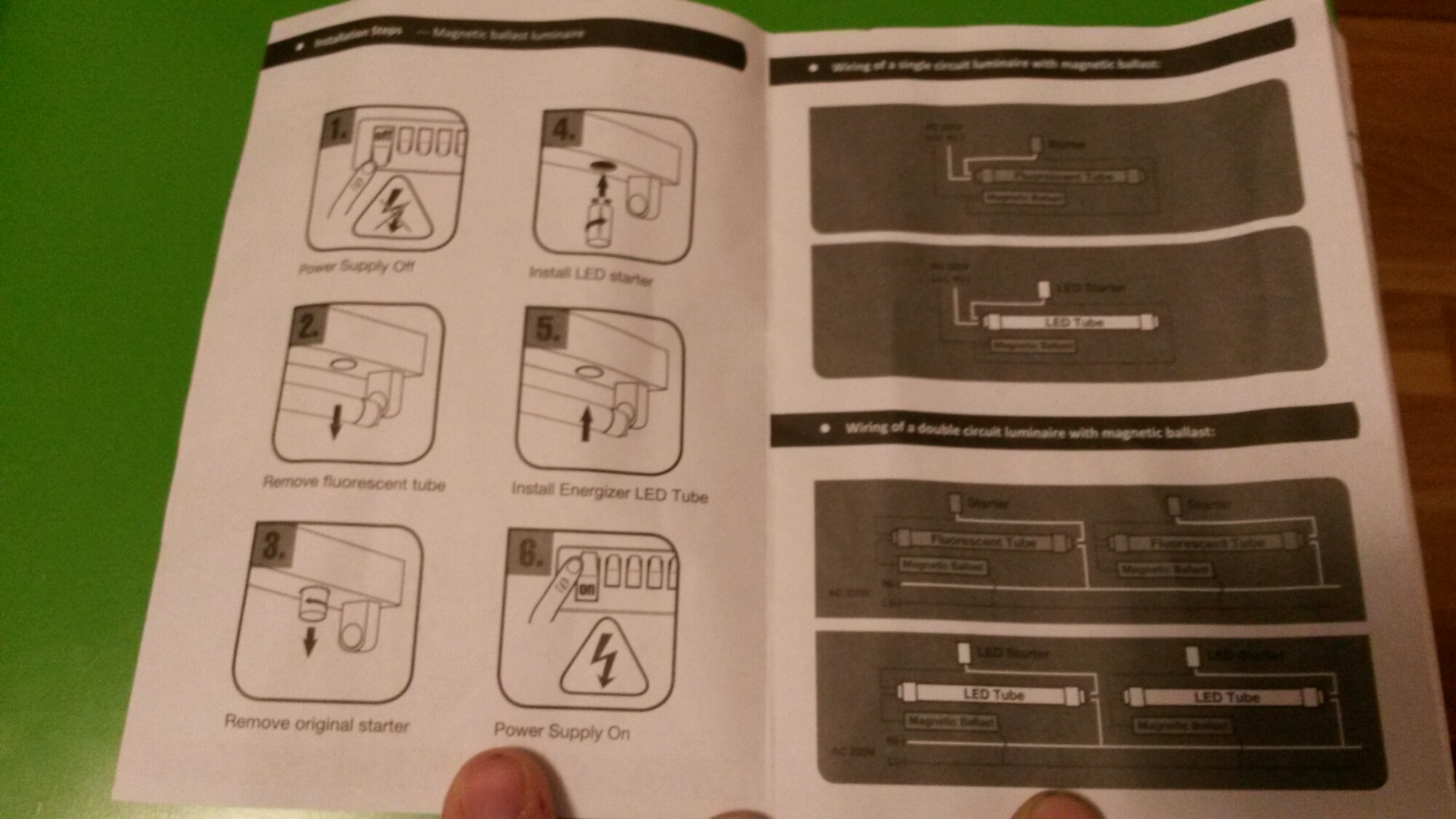
48 Comments
Tomi Engdahl says:
LED canopy shines bright at 143 lumens per watt
http://www.edn.com/electronics-products/other/4442041/LED-canopy-shines-bright-at-143-lumens-per-watt?_mc=NL_EDN_EDT_EDN_analog_20160519&cid=NL_EDN_EDT_EDN_analog_20160519&elqTrackId=47c49622096348d380cf54852d649c07&elq=dd50de34821a4c2ab77f65c62a1c788d&elqaid=32319&elqat=1&elqCampaignId=28227
An LED canopy and soffit luminaire from Cree, the CPY-20L produces 20,784 lumen with an efficacy of up to 143 lumens per watt at 5700K. The CPY-20L is the latest member of the CPY series, offering increased visibility to outperform existing LED and metal-halide options when used in fuel-pump canopies and other canopy/soffit applications. According to Cree, the CPY-20L’s high performance and efficiency allow store operators to lower operating costs, while providing safe and visually appealing lighting.
All of the canopy and soffit luminaires in the CPY series are available with a CCT (correlated color temperature) of 4000K or 5700K and a choice of a flat or prismatic drop lens. Their slim, low-profile housing is constructed of rugged cast aluminum and can be surface-mounted from below the canopy deck or even pendant-mounted. An integrated driver within the canopy housing simplifies installation.
Tomi Engdahl says:
Led tube from Finnish company Valtavalo did very well on tests did by LuxReview
More:
http://etn.fi/index.php?option=com_content&view=article&id=4537&via=n&datum=2016-06-03_11:29:34&mottagare=30929
http://valtavalo.fi/blogikirjoitukset/luxreview-testaa-valkkymaton-g4-led-valoputki-noteerattiin-kansainvalisessa-led-valoputkivertailussa/
Tomi Engdahl says:
LuxReview REVIEWED LED tubes
http://luxreview.com/review/2016/05/led-tubes-to-replace-t8-fluorescent-lamps
We bench test and rate the latest products from the major brands. Report by Lux technical editor Alan Tulla.
If you are considering replacing your existing fluorescent lamps with LED tubes, you have two choices.
If all you have to do is replace the lamp and starter (and nothing else), make sure that the LED tube complies with BS EN 62776:2015.
There are thousands of T8 installations in the UK, some quite old and in need of refurbishment. There is also the increasing need to save energy. We tested LED tubes from 12 different suppliers. All the tubes were tested at the new Lighting Industry Association laboratories in Telford, UK.
none of the LED tubes was totally correctly labelled as required by IEC 62776:2014.
Note that these LED tubes are unlikely to be suitable for use in luminaires which are used for emergency lighting. Neither can they be dimmed.
Most of the tubes we tested had fixed end caps but some were rotatable. This means that the light emitted can be angled to direct it where you most want it. I.e. the LEDs do not simply point straight down.
The full title of BS EN 62776:2015 is “Double-capped LED lamps designed to retrofit linear fluorescent lamps. Safety specifications”. It runs to 34 pages of safety tests because there is a lot to consider.
If your fluorescent lamp has an electronic ballast, you only need to swap the lamps. However, not all LED tubes are suitable for all HF ballasts. Some manufacturers, supply a ballast compatibility table.
If the fluorescent lamp has a magnetic or wire-wound ballast you will also need to replace the starter canister. No other rewiring should be required.
High power LEDs can be more glaring than a T8 lamp. If you think glare may be an issue, compare two luminaires side by side or run a glare calculation.
Colour rendering
It’s very easy to achieve high efficiency in terms of lumens per watt if you aren’t concerned about colour rendering. Any CRI greater than 80 should be OK for most applications.
Tomi Engdahl says:
LED floodlights meet diverse market needs
http://www.edn.com/electronics-products/other/4442723/LED-floodlights-meet-diverse-market-needs?_mc=NL_EDN_EDT_EDN_productsandtools_20160926&cid=NL_EDN_EDT_EDN_productsandtools_20160926&elqTrackId=a9e6155a2d8b4e77a21990fb8a81e832&elq=9534f765b0674bdf97094bb2007384f3&elqaid=34026&elqat=1&elqCampaignId=29750
Eaton has expanded its Lumark Night Falcon LED floodlight series with both large and small models to replace HID (high intensity discharge) lamps rated from 70 W to 1000 W in a broad range of commercial and industrial applications. Furthermore, the Night Falcon luminaires provide greater than 75% savings in energy and maintenance costs.
http://www.cooperindustries.com/content/public/en/lighting/resources/LightingStories/The-Lumark-Night-Falcon.html
Tomi Engdahl says:
Led Tube T8 Retrofit: Single-Ended vs. Double-Ended
https://www.eeweb.com/electronics-forum/led-tube-t8-retrofit-single-ended-vs.-double-ended
In order to reduce material and labor costs, a preferred way of replacing inefficient 32W T8 lamps is by removing them and installing ~17W LED tubes. These LEDs can come in several configurations.
The first configuration involves simply replacing the tube and reusing the existing electronic ballast. In this case initial manual labor is involved but the ballast would still require maintenance after its rated hours
The second configuration is single-ended power and using an external ballast/driver.
A third configuration is single-ended power with no ballast needed.
Existing fluorescent lamps are typically double-ended power, meaning one side of the feed is hot and the other side neutral.
I have exactly the same questions. Apparently it has been more difficult to get the dual ended designs to pass UL and FCC. It may require extra circuitry for shielding or safety. These devices are now on the market and can be purchases from Amazon, made by Hyperikon. They make both single end powered and dual end powered T8 LED bulbs. The dual end powered devices are $1.5 more per bulb.
Michele Cecchettini
(+1), 1 month ago
Score: 1
We are lighting equipment manufacturer, of course the following is our own opinion: we believe that double-ended is better because its inherent safety. Moreover, we agree with previous post stating that replacing old neon is easier.
Tomi Engdahl says:
The new standard accelerates the LED light market
21.1.2015 8:27
LED lighting tubes are the first, and so far, the only LED lamp that has received an international harmonized standard (EN 62776).
Standardization makes it possible to produce LED light tubes compatible with traditional T8 fluorescent tubes. In addition, the standard defines the characteristics of the LED light tube so that they are always compatible with each other.
With the new standard, the old fluorescent lamp can replace the LED tube with the fluorescent tube and in the future, this LED light tube can be replaced with another standard LED light tube.
The standard makes LED lighting tubes easier and safer so that LED light tubes can be expected to become more commonly replaced by fluorescent tubes.
The Valtavalo G3 + LED light tube, launched last autumn, is one of the first LED-light tubes manufactured according to the harmonized standard.
Source: https://valtavalo.fi/tiedotteet/uusi-standardi-vauhdittaa-led-valoputkimarkkinaa/
Tomi Engdahl says:
Retrofit LED tubes
Safety requirements under the new standard IEC 62776
http://www.esti.admin.ch/files/aktuell/2015-02_retrofit-led.e.pdf
Requirements for retrofit LED tubes according to the standard IEC 62776
■ Correct marking on the LED tube, correct installation and operating instructions
■ Safe interchangeability in any FL fixtures
■ Secured against falling out
■ Maximum temperatures in operation
■ Protection during inserting and removing
■Protection against unintended contact with live parts
■ Construction
■ Heat resistance
■ Compliance with photobiological safety
Requirements for marketing according to NEV
■ LED tubes that carry voltage between the two caps are still prohibited. At least basic insulation must be assured.
■LED tubes which comply with the standard IEC 62776 are permitted in Switzerland, with one exception: it is prohibited to market LED tubes that have an open/blank side
Tomi Engdahl says:
https://fi.wikipedia.org/wiki/LED-valoputki
Tomi Engdahl says:
The latest safety standard for LED tubes: what you need to know
http://luxreview.com/article/2015/06/a-new-standard-for-led-tubes
If you are thinking of replacing a fluorescent lamp with an LED tube, you should be aware of an important new safety standard introduced by the IEC (International Electrotechnical Commission) in December 2014. It’s called IEC 62776 and it covers safety specifications for double-capped LED tubes.
The standard does not apply to all retrofit LED tubes; only those where the tube is powered by the existing control gear, either electronic or magnetic, so no internal modification of the luminaire is required (except replacing the glow starter by a ‘dummy’ to complete the circuit, which is not considered a modification under this standard).
Generally, retrofit LED tubes come in two types: those where no modification to the luminaire is required (where IEC 62776 applies) and the more common type where some rewiring or bypassing of the existing control gear is needed.
In the latter, you rewire the luminaire so that the incoming mains goes straight to the lamp caps. Whether or not this is a good idea is a hotly disputed topic in the lighting world, and there is currently no specific safety standard for these lamps. However, there is general agreement among European laboratories that tests for these lamps should apply the appropriate aspects from related safety standards such as 60598, 61347 and 62031 together with a risk assessment and a detailed review of the modification instructions supplied.
Currently, most of the major lamp manufacturers build their LED tubes to meet the new IEC 62776 standard, but you should always check with your supplier.
Remember that IEC 62776 (and the other standards mentioned above) are about safety.
Tomi Engdahl says:
Retail abandons CMH lamps in favor of flexible solid-state lighting (MAGAZINE)
http://www.ledsmagazine.com/articles/print/volume-13/issue-5/features/retail/retail-abandons-cmh-lamps-in-favor-of-flexible-solid-state-lighting.html?cmpid=enl_leds_architecturalillumination_2017-06-26
Retail shops, with their long operating hours, have been among the earliest adopters of LED-based solid-state lighting (SSL) due to its high energy efficiency. Retail lighting is on anywhere from 12 to 24 hours per day, so the 80% improvement in energy efficiency for SSL pays off quickly. High-quality light and good lighting design are essential to attractive presentation of merchandise – and, therefore, to a store’s success. Energy-efficient lighting is of no benefit to store owners if their merchandise appears dull and colorless. Retailers have thus helped to push the SSL industry to deliver higher quality of light with good color rendering and a broad range of color temperatures.
Legacy lamps and narrow beams
One area, however, where retailers have been reluctant to move away from conventional lighting technology is in the use of ceramic-discharge metal-halide (CDM) or ceramic-metal-halide (CMH) lamps. They produce very high-quality light, have good light maintenance, and offer greater longevity relative to halogen lamps, which balances their relatively higher cost. Their greatest competitive advantage over high-quality SSL has been their ability to produce high flux density in a narrow beam or high center beam candle power (CBCP).
CDM lamps used in spot, track, and down lighting are central to the dramatic illumination needed for high-contrast lighting design, including the ability to illuminate a small area with high flux levels to attract customer attention to important merchandise displays. For example, CDM PAR30 lamps are generally offered in 35-39W and 70W power consumption variants. The CDM 39W PAR30 lamp has a spot beam spread of 10~15° with an initial lumen output of around 2400 lm. This lamp has a CBCP of 30,000~40,000 cd. CDM 70W PAR30 lamps have spot beam spreads of 10~15° with an initial lumen output of around 4800 lm and a CBCP of 40,000~60,000 cd.
Having met retailers’ demand for both higher lumen output levels and higher quality of light, SSL source manufacturers are now challenged to reproduce in LED-based light sources the high narrow-beam flux density delivered by CDM lamps
Achieving this goal will allow SSL to replace CDM lamps in track, spot, and down lights, as well as other key lighting applications.
Such high-lumen-density COBs enable luminaire and solid-state lamp OEMs to drop a component into their existing spot, track, and down light luminaire designs or replacement lamps. These new light sources can deliver a shaped beam from 10° narrow spots for intense light to 25° narrow flood beam spread for accent and down lighting applications while still maintaining small form factors for luminaire OEM designs or PAR30 and PAR38 lamps.
The ultrahigh-density COB arrays can be provided in a range of standard light-emitting surface (LES) diameters such as 6, 9, 11, and 14 mm, which again simplifies the integration of these CDM replacement light sources into existing designs. SSL lamp and luminaire OEMs can use their existing ecosystems for optics and connectors, while delivering new bulbs and fixtures with higher lumen output and increased CBCP to their customers.
Flexibility in color quality
Phasing out the last CDM lamps offers retailers benefits beyond cost, quality of light, and flexible lighting design attributes. It allows them to simplify their entire operation, controlling light as never before. They won’t need a mixture of lighting technologies, separate maintenance schedules for conventional and SSL technologies, or a replacement lamp inventory
Tomi Engdahl says:
How To ● Convert T8 Fluorescent Lights to LED ● Explained in Simple Terms
https://www.youtube.com/watch?v=mmR5iEEP9q8
Getting rid of the ballast and the T8 fluorescent bulbs that burn out and retrofitting and converting to LED was the best thing I have done. It was easy and the LED light is fantastic!
I made this video on how to convert and retrofitting to T8 LED’s in the hopes that others could understand what and why and how. Converting and retrofitting to LED lights is not that hard to do yourself once you understand what is happening.
Tomi Engdahl says:
Modifying an old light with LED tape.
https://www.youtube.com/watch?v=7_ds5XFJvPs
This was just a spontaneous fix of an irksome slimline fluorescent fitting that I decided to convert to a lower intensity light with some LED strip.
Tomi Engdahl says:
Making simply LED Lamp
https://www.youtube.com/watch?v=zvE4ew8ddx4
Making simply LED Lamp
Tomi Engdahl says:
Installing LED Tape Lighting
https://www.youtube.com/watch?v=6LK8S8apBy8
How to cut, connect & power LED Strip Lighting
https://www.youtube.com/watch?v=bTRLt-fzTwg
Tomi Engdahl says:
how to make led light bulb 220v, without transformer
https://www.youtube.com/watch?v=sKHuMOvD674
how to make led bulbs at home – With only a 105J capacitor, with no transformer and transistor, you can light up 42 leds with only 2w power – 220v led lamp circuit diagram
Tomi Engdahl says:
Inside a Banggood 4W LED striplight. (new camera test)
https://www.youtube.com/watch?v=UEgSNgZ0IHg
Tomi Engdahl says:
Philips T8 LED Tube Tear down: The most boring teardown yet….
https://www.youtube.com/watch?v=om180yfGego
A 48″ long T8 sized LED tube designed to replace a florescent tube. Drop in replacement (no need to change the ballast).
Tomi Engdahl says:
How to easily convert fluorescent Lights to LED –Easy Ways to Save Money
https://www.youtube.com/watch?v=SCWoI0X4jw0
How to easily convert fluorescent Lights to LED – Easy Ways to Save Money
This video will demonstrate how to replace T8 fluorescent light tubes with single-ended LED replacement bulbs. It involves 3 primary steps; removing the ballast, replacing the lamp holders, and installing the LED replacement bulbs. Additionally, we’ll cover the different types of LED tubes – single vs double ended bulbs, ballast required vs no ballast, shunted vs non-shunted lamp holders, and choosing your output and temperature color.
Tomi Engdahl says:
How To ● Convert T8 Fluorescent Lights to LED ● Explained in Simple Terms
https://www.youtube.com/watch?v=mmR5iEEP9q8
Getting rid of the ballast and the T8 fluorescent bulbs that burn out and retrofitting and converting to LED was the best thing I have done. It was easy and the LED light is fantastic! Before doing this project, switching over and converting to LED was confusing because I didn’t know what was actually happening when you retrofit from T8 fluorescent to LED lights. I watched a bunch of videos but none of them described what was actually happening with the circuits. They just cut a bunch of wires without explaining clearly. I made this video on how to convert and retrofitting to T8 LED’s in the hopes that others could understand what and why and how. Converting and retrofitting to LED lights is not that hard to do yourself once you understand what is happening.
Tomi Engdahl says:
Inside an LED T8 radar retrofit fluorescent tube. (Excelvan)
https://www.youtube.com/watch?v=9Bfgw7LbWJI
These tubes were briefly sold at an unusually low cost on eBay, so I bought one while they were available. It’s a 4-foot T8 (120cm) tube that uses about half the power of a conventional fluorescent tube and pretty much puts out half the light too. Fluorescent tubes will be brighter and last longer than their LED replacements at this point in time, so it’s unfortunate that companies that have been duped by salesmen into replacing their tubes with LED ones will end up paying the price. Especially as the process of fitting them involves the fixtures internal wiring being butchered by gangs of “lighting retrofit specialists” (labourers) in a manner that will leave them in an unknown electrical condition and incapable of taking ordinary fluorescent tubes again without serious rewiring by someone who actually knows what they’re doing.
This type of tube has the end pins shorted and requires live (hot) at one end and neutral (return) at the other. The newer ones may require live and neutral at just one end to reduce the risk of a shock from the other end while fitting the tube. Sadly, this means that a tube like this will short live and neutral completely when inserted. So whoever came up with that “safety” idea is a dick. Especially when any real electrician would not finger the other end of a tube as they inserted it in the first place as even a conventional tube can ionise and give you a shock if you touch the pins at one end while shoving the other end into a live socket.
These tube style lamps seem to commonly use buck regulators which means that the LED strips are not isolated from the mains voltage. The strips slide into an aluminium extrusion that supports the strip and cover, aids with heat dissipation and has screw-channels to allow end caps to be attached.
Under fault conditions like physical dents, water ingress or manufacturing issues it is possible for the entire aluminium extrusion of the lamp to become live. Keep this in mind as it’s inevitable that someone is going to get injured at some point, especially if they are touching a grounded reflector as they insert a faulty tube.
Tomi Engdahl says:
LED Tubes | How It’s Made
https://www.youtube.com/watch?v=5L7IPkgM-e0
Tomi Engdahl says:
LED lighting and control system design considerations
https://www.csemag.com/articles/led-lighting-and-control-system-design-considerations/
Designers need to explore various approaches and requirements to lighting design as codes and standards are becoming more energy-conscious.
As much as the previous generation of electrical engineers and lighting designers may hate to admit, the days of multilamp T8 or T12 fluorescent fixtures—with 6- to 8-ft on-center spacings, accent wall sconces, multilamp chandeliers, and wiring line voltage switches—are no longer the norm.
The energy-conscious standards, such as ASHRAE 90.1: Energy Standard for Buildings Except Low-Rise Residential Buildings, International Energy Conservation Code (IECC), and California’s Title 24, have made it more difficult to consider specifying incandescent, most fluorescent, and high-intensity discharge (HID) fixtures in modern designs. The LED revolution also brings smart, plug-and-play-style lighting devices and control systems that minimize installation and commission time, resulting in a cleaner and smarter product for the client.
Various so-called smart-switch options replace 3- and 4-way line voltage switching, as multiple zones can be controlled within the same switch instead of having to wire multiple line voltage switches. These switches can include occupancy sensors, dimming buttons, and programmable scene buttons or they can even be a small graphic touch screen, which allows multiple scenes with added control options available. The smart switches are typically powered from the room controller through the category cabling, with devices containing 2-RJ45 ports. The touch-screen option may require an additional small power supply, depending on the manufacturer.
Some manufacturers are replacing 0 to 10 V dimming cables with CAT-5e or CAT-6 cables and powering the lights and dimming with the same CAT cable.
Avoid mixing K-Temps and color rendering index (CRI) ratings, since both can cause different effects regarding how items appear in color in a building unless the application calls for it. It can be disorienting to walk from a 4000-K office into a hallway that’s 2700 K and then into the kitchen where it’s 5500 K. If the project is a partial renovation, consider matching the K-Temp to what is already installed to be consistent.
Tomi Engdahl says:
Teardown of a “27W” ultraviolet blacklight bar from eBay.
https://www.youtube.com/watch?v=GkKWyuvy48Y
I wasn’t expecting this light to actually be 27W and it didn’t disappoint. But it is actually a very well made unit with a little bit of over engineering and good serviceability for people like us.
Tomi Engdahl says:
https://www.edn.com/leds-used-to-improve-human-health-and-well-being/
Tomi Engdahl says:
Modifying an old light with LED tape.
https://www.youtube.com/watch?v=7_ds5XFJvPs&t=0s
This was just a spontaneous fix of an irksome slimline fluorescent fitting that I decided to convert to a lower intensity light with some LED strip.
My use of the current regulated supply isn’t ideal since it means that if sections of LEDs fail the current through the remaining ones will increase. It was just hard finding a tiny 12V supply that would fit inside the slim casing.
If I’d had thicker wire to hand I’d have used it. But the stuff I used is more than capable of surviving a fault current that will take out the 3A fuse in the plug. (Continuous rating 2A.)
IP65 LED tape coating fail
https://www.youtube.com/watch?v=UhmUxj9RJus
I was using this tape above my computer for ambient illumination. Over time it imperceivably changed from warm white light to a dull orange glow.
When it got the point that I couldn’t identify component colour bands I decided to take a closer look.
The gel they use to make it waterproof (more like splash-proof) has degraded through exposure to the blue/violet wavelength of the light. Directly above the LED chips it had gone so brown that it was blocking and colouring the light. Initially I thought it was the phosphor that had degraded, but when the coating is cleaned off the LED it is as bright as when new.
The LED strip was being under-run for long life, but it shows that the LEDs themselves aren’t the only factor in optical degradation. This is a good reminder that you should always treat LED tape as a consumable, and ensure it can be replaced easily in the future.
Tomi Engdahl says:
Difference between T5, T8, T12 Tubes
https://ballastshop.com/difference_between_tubes
Fluorescent lamps, or fluorescent linear tubes as they are also known, are categorized according to their wattage, shape and diameter. The “T” in T5 indicates the bulb is tubular shaped, while the “5″ denotes that it is five eighths of an inch in diameter. The other common lamps are the larger T8 (eight eighths inch = 1″) and T12 (twelve eights inch = 1½” tubes).
The T12 is an older generation fluorescent bulb that generates light through electromagnetic induction, which is considered less efficient method of creating light compared to that of newer electronic based circuits. Like the T5, the T8 tube creates light through advanced electronic circuits and are available in standard 2, 3, 4, and 5 foot lengths. However, what sets T5 fluorescent lights apart from T8 bulbs is their dramatic reduction in size. T5 lamps are 40% smaller than T8 fixtures, but are capable of containing just as much and sometimes more light in a smaller area. In other words, more T8 fixtures are needed to produced the same amount of light generated by significantly fewer high output T5 bulbs.
Tomi Engdahl says:
Fluorescent T12 Lamp Holder Screw – 47700
https://fi.rsdelivers.com/product/bjb/47700/fluorescent-t12-lamp-holder-screw-47700/0743892?cm_mmc=FI-PLA-DS3A-_-google-_-PLA_FI_FI_Lighting_Whoop-_-(FI:Whoop!)+Lamp+Holders-_-PRODUCT_GROUP&matchtype=&aud-827186183886:pla-475925916179&s_kwcid=AL!7457!3!598320124032!!!g!475925916179!&gclid=EAIaIQobChMIhLra-7Hl_AIVg4ODBx1MdAkEEAQYBSABEgK4jvD_BwE&gclsrc=aw.ds
Tomi Engdahl says:
Onko kodissasi vaarallinen ja pian kielletty lamppu? Voi tietää useiden satojen laskua
Loisteputkilamput poistuvat markkinoilta. Kielto astuu voimaan asteittain.
https://www.iltalehti.fi/asumisartikkelit/a/b86e20e8-4216-42a4-93c4-dc0aae0529a3
Euroopan unioni kieltää loisteputkilamput. Ensimmäisenä EU-direktiivi iskee pienoisloistelamppuihin, joiden tuotanto ja tuonti kielletään 24. helmikuuta.
– Muutos koskettaa monia. Pienoisloistelamppuja on kylvetty omakotitaloissa kaikkialle: pesuhuoneisiin, varastoihin, ulkovalaistukseen, sanoo Pohjois-Suomen Sähkön toimitusjohtaja Juha Lounatvuori.
Elokuussa markkinoilta poistuvat T5- ja T8-malliset loisteputket.
Syynä kieltoon on elohopea, jota loisteputkissa on. Elohopean tiedetään olevan uhka ympäristölle ja ihmisten terveydelle.
EU-alueella elohopean käytöstä on luovuttu asteittain jo vuodesta 2006 lähtien. Haitallisten aineiden käyttöä sähkö- ja elektroniikkalaitteissa säätelee RoHS-direktiivi.
Euroopan komissio on aiemmin sallinut elohopean käytön direktiivistä poiketen tietyissä käyttötarkoituksissa. Yksi näistä käyttötarkoituksista on ollut valaistus.
Elohopean käyttöä on perusteltu sillä, että riittävän energiatehokkaita elohopeattomia lamppuja ei ole ollut saatavilla. Nykyään T8- ja T5-loisteputket on kuitenkin helppo korvata led-valoilla eikä loisteputkien salliminen erillisellä direktiivillä ei ole enää tarpeellista.
Yleensä vaihdon voi tehdä omatoimisesti
Kielto näkyy kuluttajalle konkreettisesti, sillä loisteputkilamput on korvattava uusilla vaihtoehdoilla viimeistään siinä vaiheessa, kun vanhoja lamppuja ei ole enää saatavilla.
Yksityistalouksissa kiinteistön omistaja tai vuokra-asunnossa vuokralainen on vastuussa valonlähteen vaihdosta ja siihen liittyvistä kustannuksista.
Lounatvuoren mukaan led-lamppujen vaihtaminen loisteputkien tilalle maksaa kuudesta eurosta kahteenkymmeneen euroon.
Kun lasketaan kaikki yksityisasunnon polttimot ja asennus yhteen, lamppujen vaihtaminen voi maksaa sadasta kahteensataan euroon.
Isojen julkisten rakennusten, kuten vanhan koulun kohdalla puhutaan jopa kymmenistä tuhansista euroista.
Yleensä loisteputken vaihtaminen led-valoputkeen onnistuu helposti vaihtamalla valaisimeen uuden putken tai sytyttimen. Se luonnistuu myös tavalliselta kuluttajalta, eikä vaihtoon tarvita sähköalan ammattilaista.
– Led-valonlähteen vaihtaminen loisteputken tilalle on monesti yhtä helppoa kuin led-polttimon vaihtaminen hehkulampun tai pienloistelampun tilalle, Prykäri sanoo.
Ammattilaisen puoleen kannattaa kääntyä, jos ei ole varma, minkä mallinen led-valo korvaa loisteputkilampun.
Jos led-valosta haluaa ottaa kaiken hyödyn irti energiatehokkuuden kannalta, valaisimesta pitää poistaa myös vanhan putken liitäntälaite. Tätä kuluttaja ei saa tehdä itse, vaan liitäntälaitteen poistaminen vaatii aina ammattilaisen.
Loisteputkia on markkinoilla lukuisia erilaisia ja erimallisia, Lounatvuori muistuttaa. Jos väärän ledin asentaa väärään liittimeen omin päin, voi seurauksena olla hajonnut led-lamppu.
Lounatvuori kehottaakin kääntymään ammattilaisen puoleen led-polttimoita valitessa, jotta vahingoilta vältyttäisiin.
– Kannattaa kuitenkin huomioida, että loisteputki kuluttaa led-valoa enemmän energiaa ja vanhat elinkaarensa loppupäässä olevat loisteputket voivat olla myös paloturvallisuusriski, Prykäri huomauttaa.
Loisteputket ovat ongelmajätettä ja ne pitää hävittää sen mukaan. Loisteputkia otetaan maksutta vastaan vaarallisen jätteen ja sähkölaiteromun vastaanottopaikoissa.
Tomi Engdahl says:
Loisteputket kiellettiin – mitä vanhoille valaisimille ja kylpyhuoneen kaapeille pitää nyt tehdä? https://www.is.fi/taloussanomat/art-2000009416587.html
PERJANTAINA tuli voimaan pienloistelamppujen kielto, jonka myötä käytännössä viimeiset tarjolla olevat pienloistelamput roikkuvat nyt kauppojen lamppuhyllyissä.
Mitä tehdä, kun peilikaapin tai keittiön loistelamppu tulee tiensä päähän ja pimenee?
– Yleensä tilalle löytyy korvaava led, Motivan asiantuntija Päivi Suur-Uski sanoo Taloussanomille.
Suurten lampunvalmistajien verkkosivuilta löytyy valintaoppaita, joiden avulla voi etsiä omaan valaisimeen sopivaa led-lamppua. Myös kaupoissa osataan neuvoa oikean lampun valinnassa.
Asiaa kuitenkin mutkistaa se, että lampputyyppiä vaihtaessa täytyy esimerkiksi oikean lampunkannan ja valotehon lisäksi ottaa huomioon se, minkälainen valaisin on kyseessä.
Sytyttimen saa tavallinen kuluttaja vaihtaa itse. Loisteputkivalaisimessa on kuitenkin myös niin sanottu kuristin, jonka tehtävä on rajoittaa putkeen tulevan virran määrää. Kuristin ei haittaa ledin toimintaa ja se voi jäädä lamppuun. Kuristin kuitenkin aiheuttaa ylimääräistä virrankulutusta, minkä vuoksi led-lamppuun vaihtaminen ei tuota täyttä sähkönsäästövaikutusta.
Kuristimenkin voi ohittaa tai poistaa, mutta tämä on sellainen muutostyö, joka edellyttää sähköasentajan ammattitaitoa.
Ihan kaikkiin tapauksiin korvaavaa lediäkään ei löydy. Lisäksi sähkölaitteetkin ikääntyvät
– Valaisimen uusinta on aina varteenotettava vaihtoehto
Kun vanhan loistelamppuvalaisimen vaihtaa kokonaan uuteen, joka on led-lampulle suunniteltu, saavuttaa samalla energiatehokkaimman lopputuloksen.
Tomi Engdahl says:
https://valoram.fi/blogi/nykyisten-valaisimien-paivitys-led-valaisimiksi/?utm_campaign=post_led_paivitys&utm_medium=social&utm_source=Facebook&fbclid=IwAR2KRQG_-gwBo0HuJM52kIEfghDAJEY5CLifTx2yPNt0bT5hRgENJK4YLsQ
Tomi Engdahl says:
BANNED: What the end of Fluorescent Tubes Means for YOU!
https://www.youtube.com/watch?v=Ay9UiJLvJTE
It may be over 100 years old, but the venerable fluorescent tube is set to pass into history next February…we give you the low down on the bulb ban.
============================
00:00 Electrical News Weekly
00:37 Fluorescent tube will be banned
02:04 Energy label ratings have been recalibrated
02:27 Light which uses no electricity or battery
03:39 Do you think your job is dangerous?
04:23 UK needs 100,000 electricians
04:53 The average electrician is owed £7,000
06:03 The winner of our competition with Marshall Tufflex is unveiled
06:34 Thanks to our premium partners
07:32 Coming up on eFIXX this week
==============================
Tomi Engdahl says:
What’s the difference between shunted and non-shunted sockets?
https://www.youtube.com/watch?v=LovVxqiNXaM
Why is it important to know what kind of sockets or tombstones are in your linear fluorescent or LED light fixture?
First of all, using the wrong type can void the UL listing on your lamp. Second, and just as importantly, the wrong socket and lamp combination can cause an electrical short, resulting in a serious fire hazard. Additionally, using the wrong type almost always shortens the life of light bulbs.
So what is a shunted socket, anyway?
When you hear the word “shunted,” think “joined” or “connected.” Shunted sockets have internally connected electrical contacts. This provides a single track for the electrical current to travel from the ballast, through the tombstone, or socket, all the way to the lamp’s pins.
Non-shunted sockets have separate contacts –– or entry points for the wires –– creating two tracks for the electrical current to travel.
So what’s the bottom line? Whether you have a linear fluorescent tube plus ballast, LED lamp plus ballast, and even a ballast-bypass or direct wire linear LED, the specific electronics in each setup need the power to flow through the sockets in a specific way in order for everything to work properly.
Shunted & non-Shunted T8 & T12 Sockets (Tombstones) Explained by Total Bulk Lighting
https://www.youtube.com/watch?v=R6xe54orVNY
There is a huge difference between shunted and non-shunted T8 and T12 sockets, using the wrong type can end with disastrous results. Don’t worry, with our video guide we explain the difference between the two and how to be be sure you are using the correct one for your lighting application. Sit back and discover the difference between shunted and non-shunted tombstones new!
Tomi Engdahl says:
Tombstones: Everything You Need to Know!
https://www.youtube.com/watch?v=4JUpEHN0K5s
Tomi Engdahl says:
Shunted vs. non-shunted sockets: How to tell what you have
https://www.youtube.com/watch?v=hVdByYcM00A
Tomi Engdahl says:
Single vs Double-Ended T8 Installation
https://www.youtube.com/watch?v=-tB5KGXBgk0
Tomi Engdahl says:
What is Lighting Power Density?
May 11, 2023
Defined as the amount of power used by lighting per unit of building area, lighting power density is typically measured in watts/square meter.
https://www.electronicdesign.com/technologies/power/article/21265725/electronic-design-what-is-lighting-power-density?utm_source=EG+ED+Analog+%26+Power+Source&utm_medium=email&utm_campaign=CPS230504036&o_eid=7211D2691390C9R&rdx.identpull=omeda|7211D2691390C9R&oly_enc_id=7211D2691390C9R
Essentially, light power density (LPD) equates to all of the power consumed by light fixtures, ballasts, controls, transformers, etc., and is included in the watt measurement. If any other device or component is involved in lighting, then it must also be included in the calculation.
Tomi Engdahl says:
Onko kodissasi vaarallinen ja pian kielletty lamppu? Voi tietää useiden satojen laskua
Loisteputkilamput poistuvat markkinoilta. Kielto astuu voimaan asteittain.
https://www.iltalehti.fi/asumisartikkelit/a/b86e20e8-4216-42a4-93c4-dc0aae0529a3
Euroopan unioni kieltää loisteputkilamput. Ensimmäisenä EU-direktiivi iskee pienoisloistelamppuihin, joiden tuotanto ja tuonti kielletään 24. helmikuuta.
– Muutos koskettaa monia. Pienoisloistelamppuja on kylvetty omakotitaloissa kaikkialle: pesuhuoneisiin, varastoihin, ulkovalaistukseen, sanoo Pohjois-Suomen Sähkön toimitusjohtaja Juha Lounatvuori.
Elokuussa markkinoilta poistuvat T5- ja T8-malliset loisteputket.
Syynä kieltoon on elohopea, jota loisteputkissa on. Elohopean tiedetään olevan uhka ympäristölle ja ihmisten terveydelle.
EU-alueella elohopean käytöstä on luovuttu asteittain jo vuodesta 2006 lähtien. Haitallisten aineiden käyttöä sähkö- ja elektroniikkalaitteissa säätelee RoHS-direktiivi.
Euroopan komissio on aiemmin sallinut elohopean käytön direktiivistä poiketen tietyissä käyttötarkoituksissa. Yksi näistä käyttötarkoituksista on ollut valaistus.
Elohopean käyttöä on perusteltu sillä, että riittävän energiatehokkaita elohopeattomia lamppuja ei ole ollut saatavilla. Nykyään T8- ja T5-loisteputket on kuitenkin helppo korvata led-valoilla eikä loisteputkien salliminen erillisellä direktiivillä ei ole enää tarpeellista.
Yleensä vaihdon voi tehdä omatoimisesti
Kielto näkyy kuluttajalle konkreettisesti, sillä loisteputkilamput on korvattava uusilla vaihtoehdoilla viimeistään siinä vaiheessa, kun vanhoja lamppuja ei ole enää saatavilla.
Yksityistalouksissa kiinteistön omistaja tai vuokra-asunnossa vuokralainen on vastuussa valonlähteen vaihdosta ja siihen liittyvistä kustannuksista.
Lounatvuoren mukaan led-lamppujen vaihtaminen loisteputkien tilalle maksaa kuudesta eurosta kahteenkymmeneen euroon.
Kun lasketaan kaikki yksityisasunnon polttimot ja asennus yhteen, lamppujen vaihtaminen voi maksaa sadasta kahteensataan euroon.
Isojen julkisten rakennusten, kuten vanhan koulun kohdalla puhutaan jopa kymmenistä tuhansista euroista.
Yleensä loisteputken vaihtaminen led-valoputkeen onnistuu helposti vaihtamalla valaisimeen uuden putken tai sytyttimen. Se luonnistuu myös tavalliselta kuluttajalta, eikä vaihtoon tarvita sähköalan ammattilaista.
Tomi Engdahl says:
Poista tämä lamppu käytöstä välittömästi
Kyseinen led-valaisin pitää poistaa käytöstä välittömästi turvallisuuspuutteiden takia.
https://www.iltalehti.fi/kotimaa/a/3a098b21-11b8-4d43-b4b6-9c0c99341a23
Turvallisuus- ja kemikaalivirasto (Tukes) kehottaa kuluttajia poistamaan Eurolamp 147-55352 led-valaisimen käytöstä välittömästi.
Tukesin mukaan tuotteessa on turvallisuuspuutteita, eikä se täytä sähköturvallisuuslain eikä tuotetta koskevan EN 60598 -standardin vaatimuksia. Valaisimesta puuttuivat kaikki standardien vaatimat merkinnät, mukaan lukien CE-merkintä.
Tuotteessa on turvallisuuspuutteita, jotka aiheuttavat sähköiskun riskin. Valaisimen verkkojännitteisten osien ja kosketeltavien metalliosien välillä on riittämätön erotus. Valaisimen maadoitusliitäntä ei myöskään ole luotettava.
Tuote kehotetaan poistamaan välittömästi käytöstä. Tuotteen vastuuyritys Finvalo Ky pyytää kuluttajia ja muita loppukäyttäjiä palauttamaan tuotteen.
Tomi Engdahl says:
https://m.facebook.com/story.php?story_fbid=pfbid0272KiDkt1Z6498xg5Ct7tvmQMHwg4PGYPbnJf9UFJvc3aEAVazX41zqHExrCgVhogl&id=100054476260206
Tärkeä muistutus kaikille, jotka käyttävät T8- ja T5-loisteputkia valaistuksessaan! ⚠️
EU:n ekosuunnitteludirektiivin valaistusta koskeva asetus astui voimaan 1.9.2021, ja sen myötä loisteputkien valmistus loppuu 24.8.2023. Tämä tarkoittaa sitä, että jos käytät loisteputkia valaistuksessa, nyt on aika siirtyä led-valoputkiin.
Loisteputkien korvaaminen led-putkilla on mahdollista, mutta se voi vaatia muutoksia valaisimen runkoon. Vanhojen valaisimien päivittäminen ledeille sopiviksi ei kuitenkaan ole vaikeaa, ja samalla kannattaa tarkistaa koko valaisimen kunto.
Ledit ovat monessa mielessä loisteputkia parempi valonlähde, sillä ne kestävät pidempään, tuottavat parempaa valotehoa ja ovat energiatehokkaampia. Lisäksi ledien säätömahdollisuudet ovat selkeästi paremmat kuin loisteputkien.
Muistathan aloittaa valaisinten saneerauksen ajoissa, jotta ehdit saada valaisimet kuntoon ajoissa. Loisteputkien poistuminen on myös hyvä paikka tarkastella koko valaistusta ja korjata mahdollisia ongelmakohtia. Asiantuntijamme auttavat mielellään kaikissa valaistukseen liittyvissä kysymyksissä!
Lue lisää: https://bit.ly/3ON3QN6
Tomi Engdahl says:
Loisteputkien valmistus loppuu – oletko varautunut
https://valoram.fi/blogi/loisteputkien-valmistus-loppuu-oletko-varautunut/?utm_campaign=post_loisteputkien_valmistus_loppuu&utm_medium=social&utm_source=Facebook&fbclid=IwAR0PuaO_4k9ii0RJbapWk95iwEwlZ1dy7xjyn3oZ_XI0D5e_gipSQ0YOsj8_aem_AU1BNW4S60EbY4prpISxkg2GFotxalQjRVGI16B8DSfxLzzEG5qr9yKSC0VJG7jitkLfm2DcrKKwikrMlKanC7ZR
Merkittävä vaikutus monen liike- ja toimitilakiinteistön sekä teollisuuslaitoksen näkökulmasta on, että T8- ja T5-loisteputket poistuvat markkinoilta 24.8.2023. Ne korvataan led-valoputkilla samaan tapaan kuin led-valot ovat korvanneet hehkulamput ja elohopealamput. Valmistajista esim. Osram on ilmoittanut lopettavansa loisteputkien myynnin asteittain.
Loisteputkien vaihdon yhteydessä koko valaisin kannattaa tarkastaa
Vanhojen loisteputkien korvaaminen led-putkilla on mahdollista, mutta vaihto voi vaatia muutoksia myös valaisimen runkoon. Vanhat valaisimet voidaan päivittää ledeille sopiviksi poistamalla kuristin ja mahdollistamalla suorasähkökäyttö. Näin tehohäviö pienenee. Työ on yksinkertainen ja nopea tehdä samalla, kun valaisimen kunto tarkastetaan.
Ledit tuottavat parempaa valotehoa pienemmällä energiankulutuksella
Vaikka direktiivin taustalla ovat ympäristölähtökohdat, led-valaisimet ovat monessa mielessä muutenkin perinteisiä loisteputkia parempi valonlähde. Ne kestävät n. viisi kertaa pidempään kuin loisteputki, syttyvät nopeasti ilman välkkymistä ja tuottavat huomattavasti miellyttävämmän valaistuksen tasaisen valonsa vuoksi. Lisäksi ledien säätömahdollisuudet ovat selkeästi paremmat kuin loisteputkien.
Tomi Engdahl says:
How Can You Escape the Fluorescent Tube BAN?
https://www.youtube.com/watch?v=m_tH_g9KXHY
As the ban on T5 and T8 fluorescent tubes approaches, you may wonder what alternatives are available. Is investing in a new lighting fixture the only solution, or could simply replacing them with LED tubes be a viable option? In this video, Gordon Routledge explores the various options, including a hybrid approach for more demanding applications developed by LEDVANCE. Discover the best path forward as we navigate this transition in lighting technology.
00:00 RoHS signals the end of the road for T8 & T5
00:49 What are the alternatives to fluorescent
01:20 New lighting fixtures
03:05 Retrofitting with LED tubes
04:05 Energy labelling performance labels have changed
04:40 What about existing ballasts and control gear?
05:30 Ledvance LED tube power supply with Dali dimming
06:20 Challenging situations – remanufacturing
07:10 Hybrid lighting fixture in a fixture
Tomi Engdahl says:
Loisteputkien aikakausi päättyy tänään
https://etn.fi/index.php/opinion/15238-loisteputkien-aikakausi-paeaettyy-taenaeaen
Tämä päivä, 24. elokuuta 2023 tulee jäämään historiaan, kun EU:n päätös kieltää elohopeaa sisältävien loisteputkien myynti tulee voimaan. Vaikka elohopean käytöstä on luovuttu asteittain aina vuodesta 2006 lähtien, on elohopeaa sisältävien valonlähteiden, kuten T8- ja T5-loisteputkien käyttö ollut edelleen sallittua. Nyt on hyvä aika miettiä, mitä vanhan loisteputkivalaistuksen tilalle jatkossa hankitaan.
Tänä päivänä loisteputket on helppo korvata energiatehokkaammilla ja ympäristöystävällisemmillä LED-vaihtoehdoilla. Myös valonlähteen vaihdettavuus voidaan säilyttää entisen kaltaisena, ja näin toteuttaa huoleton ja pitkäikäinen valaistus mitä erilaisimpiin tiloihin ja toimialasta riippumatta. Valonlähteen vaihdettavuuteen ja kestävään materiaalien käyttöön kannustaa myös vuonna 2021 voimaan tullut EU:n Ecodesign-direktiivi, jonka tavoitteena on erityisesti kiertotalouden edistäminen ja materiaalihävikin minimointi.
Useissa tapauksissa vanhat loisteputket voidaan korvata suoraan LED-putkilla, ja näin vanhat käyttökelpoiset valaisinrungot saavat lisää edullisia käyttövuosia. Hankintaa tehdessä kannattaa kuitenkin aina varmistaa uuden lampun ja vanhan valaisimen yhteensopivuus. Emme esimerkiksi suosittele asentamaan LED-putkea suoraan elektronisella liitäntälaitteella varustettuun valaisimeen, vaan liitäntälaite kannattaa aina ensin poistaa. Jos valaisinrunko on jo parhaat päivänsä nähnyt, kannattaa se vaihtaa erityisesti LED-putkille suunniteltuun valaisinrunkoon, johon valitaan käyttötarkoituksen mukaiset vaihdettavat valonlähteet.
Tomi Engdahl says:
problems with old magnetic ballasts that had line frequency flicker.
That is also a problem on many many LEDs and they’re often worse as the efficiant phosphors used on them have less persistence compared to the older T12 fluros that were quite tolerable when driven on a line frequency ballast. The mistake with fluros was the shift to efficient phosphors but not driving them electronically.
Tomi Engdahl says:
https://www.sylvania.fi/images/pdf/T8_LED-putkien_kytkent%C3%A4ohje.pdf
Tomi Engdahl says:
https://tukes.fi/sahkotyot-ja-urakointi/loisteputkivalaisimen-muuttaminen-led-valoputkikayttoon
Tomi Engdahl says:
Urakoitsija kun tekee ns.valosaneerauksen/valohuoltoa esim 2x58w -80 luvun loisteputkivalaisimeen.
1. Pura valo
2. Ohita ja poista kuristin
3. Poista mahdollinen kompensointikonkka(iso)
4. Poista mahdollinen pikku “häiriöpoistokonkka” sokeripalan yhteydestä.
5. Kasaa valo ja asenna 1,5m T8 Led putket.
6. Asenna mukana tullut “sytytin” paikaleen. Sisältää jumpin tai sulakkeen .
6. Nauti “uudesta” valosta
Konkat ym pois koska:
A: Vikakohteet ja tulevaisuuden murheet vähenevät poistamalla. Esim paloturvallisuus!
B: Kulutus “lisääntyy” turhan kapasitiivisen kuorman lisääntyessä.
C: Konkat/kuristimet ovat 5min poistettavissa ja täysin turhat lediputkien kanssa.
T:Sähkäri
Tomi Engdahl says:
Ei ole mitään käytännön merkitystä. LED:in pienellä virralla kuristin toimii käytännössä vain pitkänä johtona. Se minimaalinen sähkönkulutus, mitä magneettikentän tuottaminen LED:in virralla kuluttaa on mitätön.
Jos kuristimen ohittaa, niin eikö valaisin pidä silloin merkata jollain tavalla, että kytkentää on muutettu? Yksiputkinen toimii hyvin vaikka ei ohitakaan, kaksiputkiset (yhdellä kuristimella) vilkkuu?
Tomi Engdahl says:
Huimia laatueroja ja ledit himmenevät sitä nopeammin mitä kuumempana käyvät. Yleensä halvoissa ledilampuissa juuri jäähdytys on se osa mistä on säästetty sen lisäksi että yksittäisiä ledejä ajetaan suuremmalla virralla, jotta sama valo saadaan pienemmästä ledimäärästä. Tuo vielä pahentaa ongelmaa.
Eli ledien pitkä kestoikä vaatii ledin pitämistä viileänä, ledichipin kestoikä yleensä karkeasti puolittuu jos lämpötila nousee 10°C. Eli jos ledi saadaan pidettyä vaikka 40 asteisena 60 asteen sijasta, saadaan nelinkertainen elinikä.